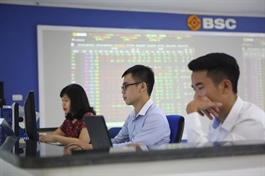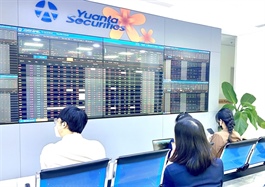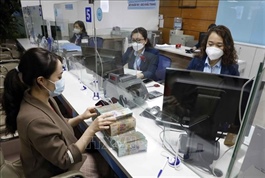Cautious optimism surrounds understated insurance stocks
Cautious optimism surrounds understated insurance stocks
Insurance stocks have been underwhelming, with low liquidity and narrow price fluctuations making them less appealing to investors looking for quick gains.
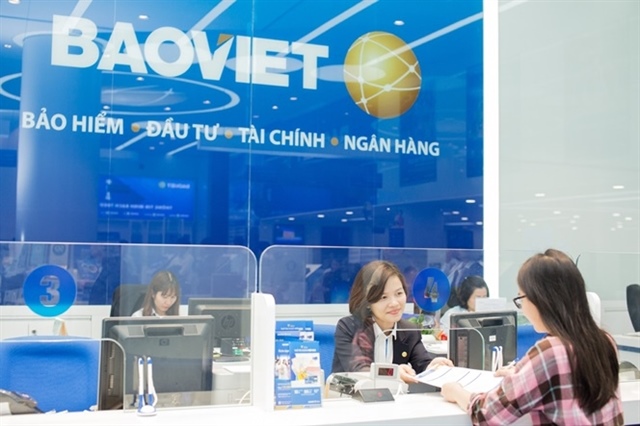
A teller talks to a customer at a Bao Viet Group transaction office. — Photo baoviet.com.vn |
The Vietnamese insurance sector is currently facing challenges that may deter short-term investors, despite the long-term growth potential it offers.
Recent market analysis shows that insurance stocks have been underwhelming, with low liquidity and narrow price fluctuations making them less appealing to investors looking for quick gains.
Insurance stocks have remained largely stagnant or exhibited minimal price increases, even as the VN-Index has shown significant upward movements.
For instance, shares of companies like Petrolimex Insurance Corporation (PGI) have traded around VNĐ20,000 per share since June, with similar performance noted for stocks like Agriculture Bank Insurance JSC (ABI), DBV Insurance Corporation (AIC) and Sài Gòn-Hà Nội Insurance Corporation (BHI).
Bảo Minh Insurance Corporation (BMI), on the other hand, has seen a decline from its price range of VNĐ20,000 to VNĐ21,000.
While some leading stocks, such as Bảo Việt Holdings (BVH), Military Insurance Company (MIG) and PVI Holdings (PVI), have shown slight improvements, these gains have been modest compared to the broader market's performance.
This stagnation is concerning, especially given that the insurance sector has demonstrated robust growth in operational results during the second quarter.
For example, Bảo Việt Group reported a gross profit from insurance operations of VNĐ592 billion (US$22.5 million) in Q2, a significant recovery from a loss of VNĐ402 billion during the same period last year.
The group's financial profit also rose from nearly VNĐ2.6 trillion to VNĐ2.7 trillion, leading to a profit after tax of VNĐ705 billion, a 60.6 per cent increase.
Similarly, Military Insurance experienced a 23 per cent rise in gross profit from insurance activities, boosting its net profit after tax by 49 per cent.
Data from InvestingPro showed that institutional investment in Vietnamese insurance stocks remained modest, typically accounting for just 1 to 5 per cent of fund portfolios. The limited exposure reflected both structural challenges within the sector and the cautious sentiment of investors.
By the end of May, the total gross written premium of Việt Nam’s insurance industry reached VNĐ92.5 trillion, up 4.4 per cent year-on-year, with life insurance accounting for VNĐ57.3 trillion, a gain of 1.5 per cent, according to the Insurance Association of Việt Nam.
While these figures confirmed ongoing growth, the pace remained moderate, indicating that the industry was expanding but not accelerating.
Insurance companies are inherently capital-intensive businesses. Their balance sheets are built on long-term liabilities and they must maintain significant reserves and solvency margins to satisfy regulatory requirements.
As a result, profit distribution through dividends is often constrained. Under current regulations, an insurer can only pay dividends after meeting all reserve obligations, ensuring solvency and generating profits after tax.
This structure provides financial stability but limits flexibility in rewarding shareholders.
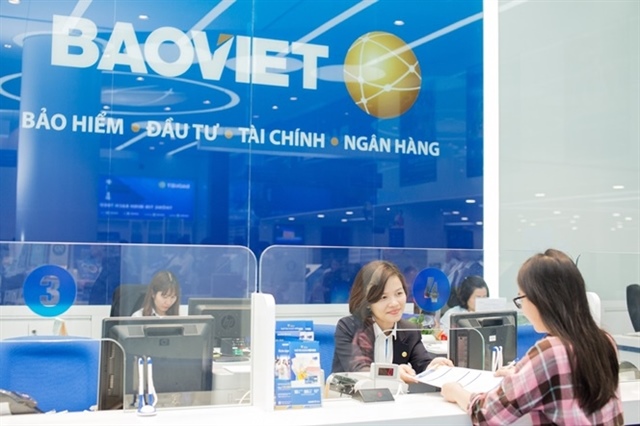
A teller talks to a customer at a Bao Viet Group transaction office. — Photo baoviet.com.vn |
Liquidity is another barrier to the sector’s appeal. Trading volumes of most insurance tickers remain relatively low, making them less attractive to short-term investors or funds seeking high turnover.
Moreover, the performance of many insurance stocks has been subdued due to a lack of strong catalysts. Without dramatic earnings surprises, mergers and acquisitions, or regulatory breakthroughs, share prices tend to move within narrow ranges.
Earnings volatility also stems from insurers’ reliance on investment income rather than underwriting profits.
In Việt Nam, a significant portion of insurers’ returns is derived from financial investments, primarily in bonds, equities and real estate.
When capital markets fluctuate or interest rates adjust, these investment portfolios can directly impact profitability, adding another layer of uncertainty to share performance.
Long-term optimism
Despite these near-term challenges, analysts see room for optimism.
The government's development plan for the insurance industry envisions premium revenue reaching 3 to 3.3 per cent of GDP by 2030, suggesting substantial long-term growth potential.
This projection is supported by Việt Nam's expanding middle class, rising financial literacy and the gradual integration of international standards in insurance management and corporate governance.
As the industry modernises, improved transparency, digital transformation and a more sophisticated regulatory framework are expected to enhance the sector's appeal.
These changes could make insurance stocks more attractive to both domestic and foreign institutional investors who value consistency, compliance and predictable returns.
For now, though, insurance shares are likely to remain a defensive option rather than a growth story.
- 09:38 27/10/2025











